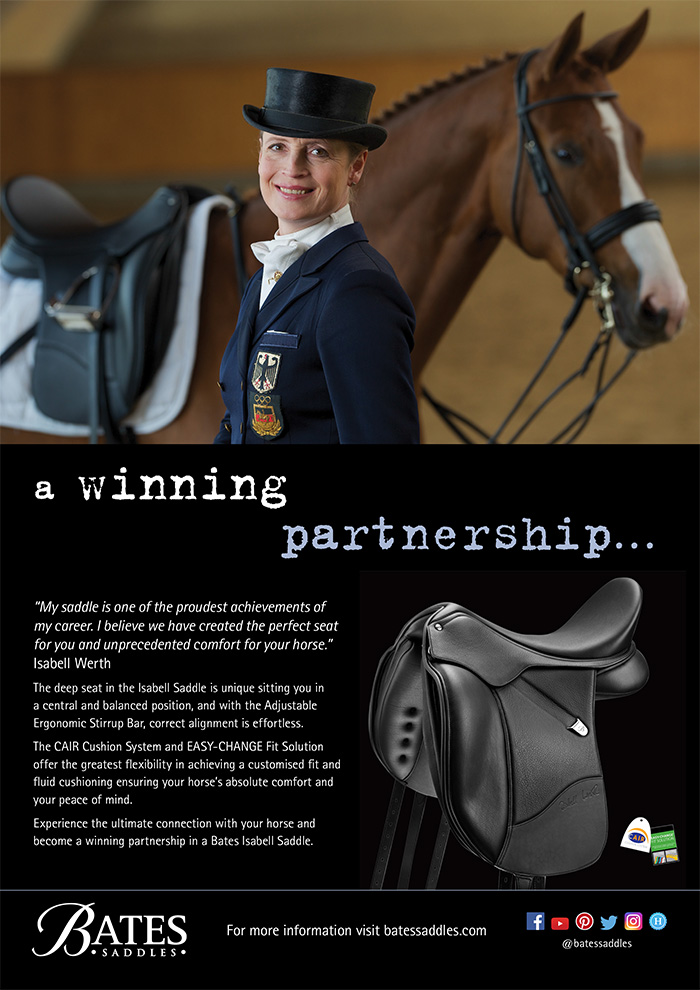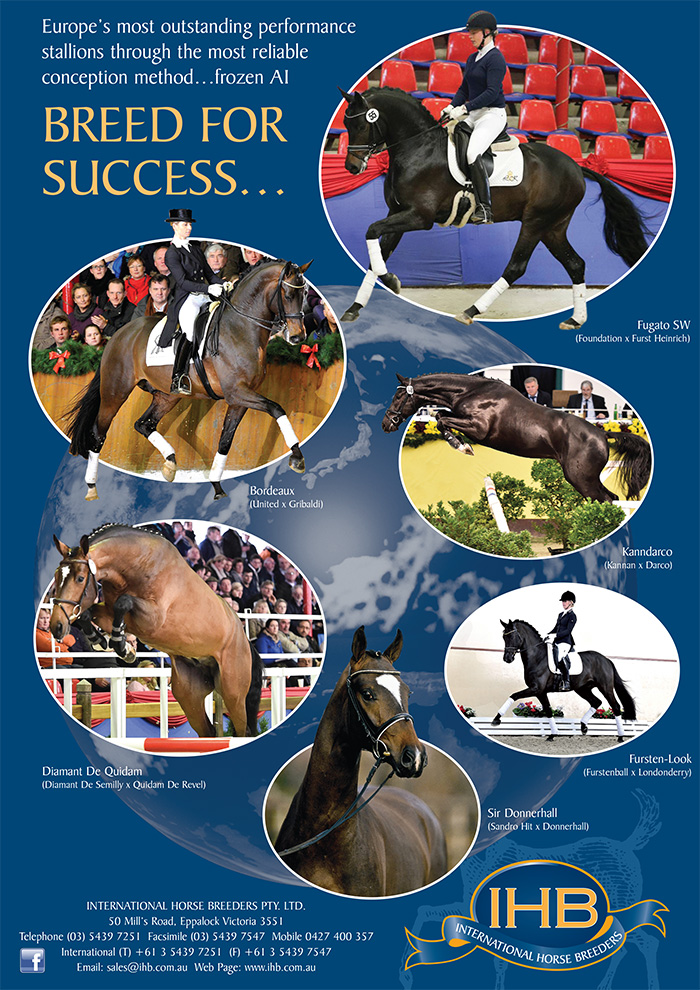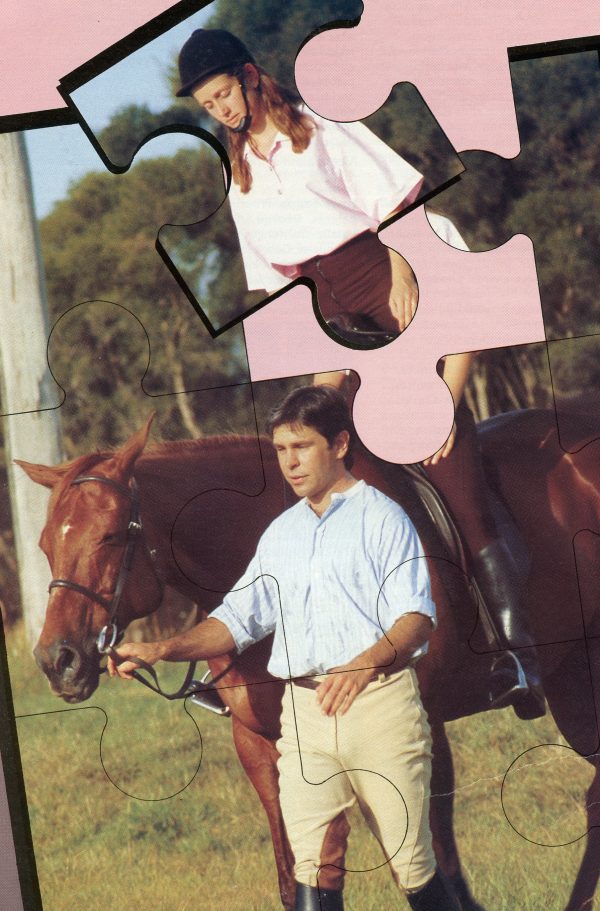
Back in the 80’s, riders and coaches were looking for new ways to teach and ride, and many of them found their answer in Sally Swift’s book, Centred Riding. Young Australian, Richard Weis traveled the world to get to the bottom of this new approach…

Perhaps no other writer, or no other book, has inspired greater enthusiasm than Sally Swift’s Centred Riding. Overnight we had a whole new way of looking at the mystery of coordinating your body with the body of the horse – and a teaching philosophy that is so fresh and inspiring. Sally Swift’s book is unique, the product of an exceptional life, a life spent in the search of truth. Certainly Centred Riding was the book that proved a revelation to one young Australian riding teacher. Suddenly Richard Weis found that on the other side of the world, a renowned teacher of riders had evolved a philosophy that answered the questions he had been asking…
Richard Weis is fond of re-telling a quote from one of his American students – a quote that seems to sum up his equestrian and teaching philosophy: “The student was a Canadian, just about to finish her doctrate in physics, a very cranial sort of person, really rather out of touch with her feelings, her body, her feeling senses. After a lesson she came up to me and said: ‘My horse is a natural biofeedback machine, now I’m sensitive enough to read his responses, he monitors my every thought, and feeling and action’.
“Now I feel that developing that quality to feel in riders is my task. The quality that will allow their body to fit in and cooperate with the horse. The realization that how they think and feel will affect how their horse is thinking and feeling. If the rider is tense and angry, the horse worries. If the rider is relaxed and confident, he works smoothly and confidently.”
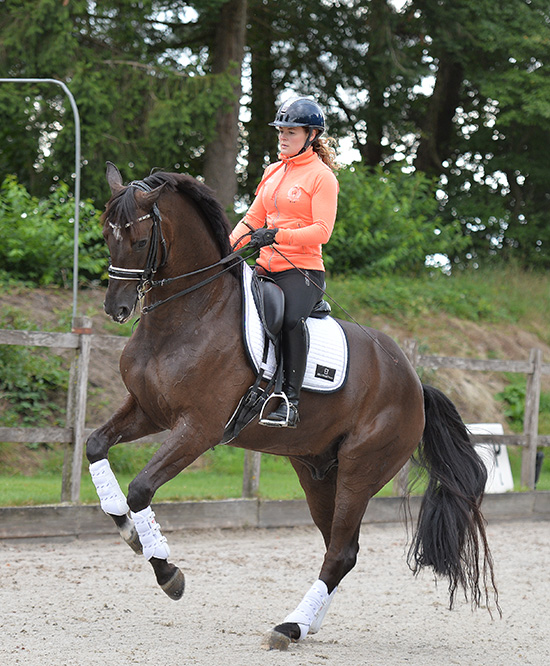
“That is what the centred riding approach is all about, the thrill of being as one, absorbed in the performance of exacting tasks with a willing and obedient equine partner. The two bodies synchronized… ”
For Richard the centred riding approach was a logical development of a whole way of looking at life:
“I had a long term interest in mind/body techniques… yoga, the Alexander Technique. I spent about eighteen months in India and South East Asia, and I was fascinated by the looseness and mobility of the Asian body. When I started to train as a riding teacher in 1977 I couldn’t understand why I was being told to do so many things that were against the natural functioning of my body. Like ‘SIT UP STRAIGHT- which immediately makes your body go rigid, or ‘PUT YOUR HEELS DOWN’, same effect. Anatomically it didn’t make any sense to me. ”
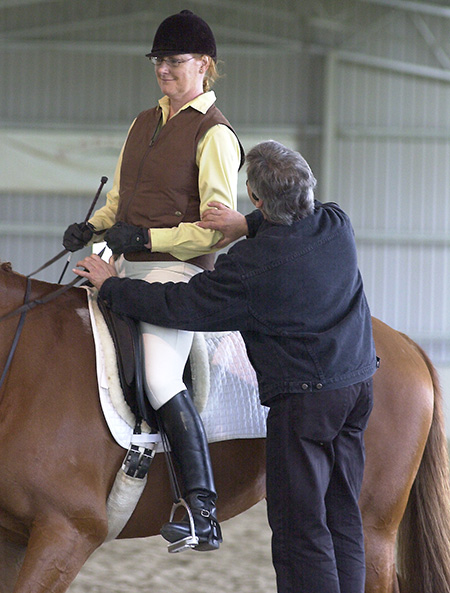
“As I understood it, mastering the ‘classical seat’ was meant to bring the rider to a state of balance and the physical freedom to go with the horse in movement. It leads to a question which has dominated my riding and teaching career for the past ten years – just how is it that a rider can take up the classical seat and maintain it in movement without gripping or holding excess tension?”
“Mary Hovers, my instructor, sympathized with the dilemma and was interested to look into it with me from a fresh angle. I started directing yoga classes in the mornings before riding. Mary and the other A.I. students came along and we did postures and relaxation techniques which I considered appropriate for riders.” The experience started Richard thinking about the human body – and the rider: ‘The more I got into riding teaching, the more I realised that a lot of our language was inappropriate and what we were doing in a lot of cases was causing people to stiffen and tighten – actually getting them OUT of the experience of being able to feel what their horse was doing.”
next Richard travels to England
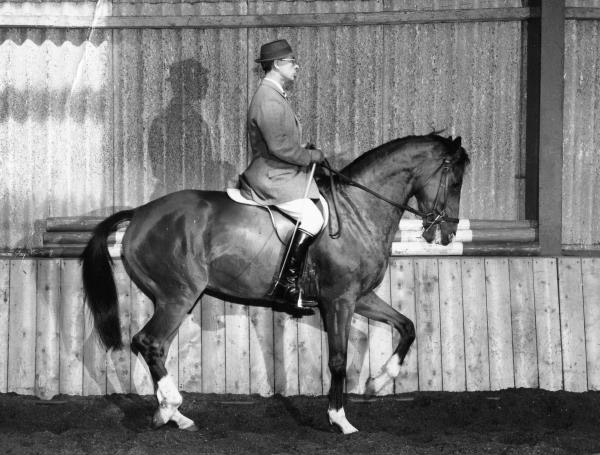
Geoffrey Hatton on Queens Council
“I became more involved in yoga, and when I went to England tried to work with Geoffrey Hatton, who combines yoga and meditation with riding instruction, but he had just left the Wirral and moved to a Meditation Centre.”
“So I decided to train for the Intermediate with Pat Manning. Pat and her assistant at the time, Dorothy Willis are excellent instructors, absolutely wonderful. They both had a wonderful ‘eye’ for horse and rider. I learned a lot about what I wanted my body to do and how my horse should respond. At Arborfield it dawned on me that if I was ever to sit on a horse whose movement was truly light, elastic, balanced and free, it would be because I had developed similar qualities in the functioning of my own body. I also realised that to find the key to this development I would have to look outside the realm of traditional riding instruction.”
“I came back to Australia in ’79 and promptly sustained a back injury, which was probably the best thing that could have happened to me, because from being a fairly strong active rider, all of a sudden I couldn’t be strong at all. So I started to think, there must be a soft way to approach all of this, there must be a way that is appropriate to my body even though I’ve got this permanent injury.”
“I had a couple of years working at the New England Girls School where I had a hundred or so girls as my riding students, and it was a fantastic opportunity to watch riders in various stages of development – from young children about seven or eight, who still have fairly free naturally working bodies, to seventeen, eighteen-year-old girls who are becoming very self conscious and very aware of their femininity and very complicated in the workings of their mind and body. It was a lovely range to observe, and I found that the younger students were capable of allowing a natural functioning to emerge in their coordination and balance. They hadn’t been messed up with those extra years.”
“The older students were already starting to show what will probably be permanent locking patterns in their bodies.”
“I eventually left the school because I was becoming so fascinated in the direction my approach was taking that I wanted to have the freedom of my own place to investigate it. So I moved to Toowoomba and started my own riding school.”
“I did a lot of work with riders on the ground, bending and stretching exercises, things from yoga and Tai Chi. I found that I was a little bit inhibited about teaching this approach because I wasn’t seeing it done anywhere – and I kept right out of the way of the traditional riding scene for about four or five years.”
“Then one of my students said ‘Hey there’s no need for you to apologize any more for this approach, Sally Swift has put it all in a book – and here it is!’ I stopped everything and read it in one day and one night. I phoned Sally the next day and said: ‘You’ve just legitimized a whole lot of thinking I’ve been doing’. And she said ‘Well we should work together’. She invited me over to be her first ever apprentice in the States – and that’s where I spent three months last year.”
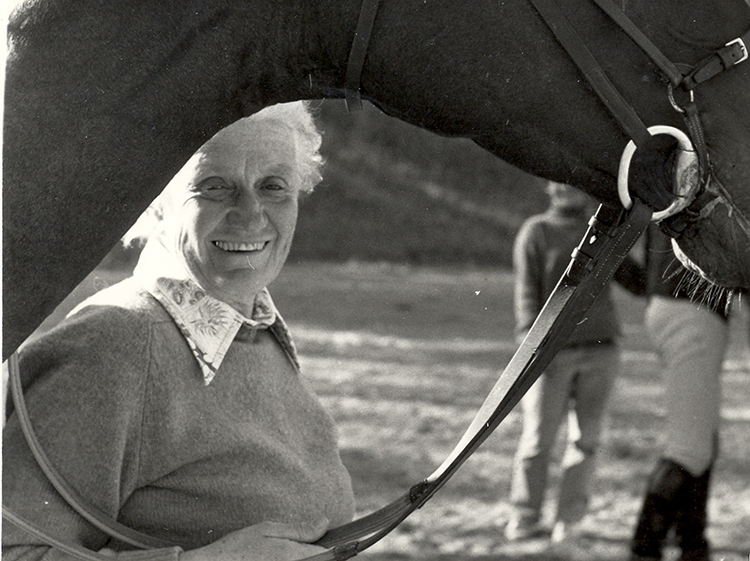
“Sally also has a back problem, she also has a background in Alexander technique, and she has also been involved in a number of mind/body disciplines. Here was this wonderful, successfulteacher – and teacher to all sorts of standards – and telling me – ‘You are on a track that’s pretty new, and pretty exciting, really go for it!’ The more I watched Sally work the more I realised the unlimited potential of the approach she has pioneered.”
“Sally works to re-educate riders in the way they use themselves. She teaches her pupils to release tension in order to adopt the classical seat. This means that the joints – particularly the hip joints and lower back – are free to absorb the movement of the horse.”
“In fact it was not, Sally who introduced me to these ideas. A few months earlier, an Alexander teacher, Mary Cerny, gave me a lesson. During this fateful half hour, I came to a stunning realization. I realized that Mary knew far more about the subtleties of the Classical Seat than I did – and she had never ridden a horse!”
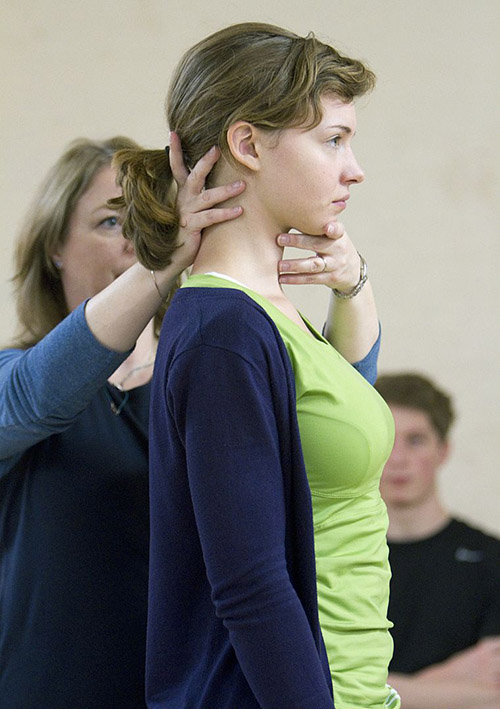
“Through her Alexander Training, Mary was able to introduce me to new levels of fluidity in the saddle. I was ecstatic – here was the missing link!”
“Despite the gloomy forecasts of the medical specialists, the Alexander Technique gave me – as it had Sally Swift – a whole new lease of life.”
“When I arrived in America my mission was to learn as much about Centred Riding AND the Alexander Technique as possible.”
“Sally was more than encouraging. She organized for me to work with her Alexander teacher, Peter Payne, and in fact insisted that all her subsequent apprentices have Alexander lessons.” ”
After three months with Sally I moved to Lincoln, Nebraska, to do a one month residential with Marjorie Barstow. Marj is an 87-year-old teacher who was part of Alexander’s first teacher training course. She is also a horsewoman, businesswoman, as well as being a tireless and phenomenal teacher.”
“She left me with a very clear understanding of natural body reflexes – how the human organism is meant to function efficiently. She also gave me some valuable clues about how to spread this new found knowledge to my students.”
“The more I go on, the more I am incorporating that sort of knowledge into my teaching – and I find that it is the horses that are the beneficiaries. Often we find that we get in the way of our horse’s natural functioning by making our bodies rigid. If we start to deal with our whole body and the flow of energy in the movements, we can then get a centred feel. The more I work on riders, the more I see horses developing fluid movement.”
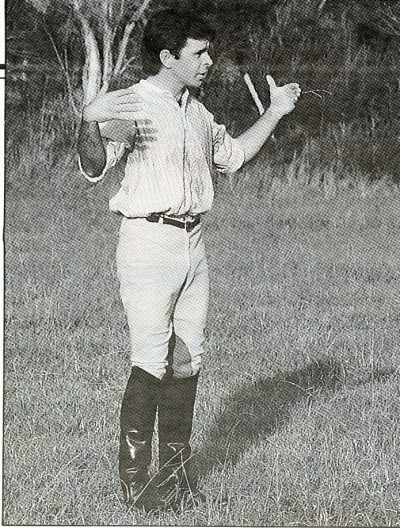
The concepts are exciting but how would they work in a specific teaching situation. What does Richard do when a new student comes to him?
“My first job is to give the student the feeling of being centred on the horse. By centred, I mean absolutely balanced so that each part of the body is maintaining the least amount of tension that is necessary to maintain the body’s form – no extra. By finding that balance I want to give the rider the feeling of being totally present, with all their senses, on the horse at that particular moment. That means that they should have complete vision, they should be able to smell, to hear, to feel, to balance, all at once and without any excess effort.”
“Now to get to that state we have to be aware of the different areas of the brain. The brain has a right and a left side, this is an oversimplification, but it does for our purposes, and the right side is the artistic, feeling side of the brain, the side that deals in images and a total picture.”
“The left side of the brain is the side that functions in collating, finding linear order, criticising, discussing, talking – any specific organizational activities.”
“To bring riders into a sense of their whole body, I need to give them access to the right side of their brain. That involves an exercise of body awareness, where they will rotate their awareness from different parts of their body in a little guided tour that I take them on. During that time I encourage them not to talk to me at all because talking is very much a left brain function.”
“The guided tour is to promote an awareness of their entire body and that is then guided into a feeling of support for the body – where the horse is supporting the body from falling to the ground. By feeling that support very strongly, an antigravity reflex is stimulated in the body – which allows the body to grow tall without any effort. It is the opposite of saying ‘Sit it up straight’, it is something that automatically happens to you when you feel the support below you.”
“We work on balancing the body, feeling the support and feeling the upthrust from the horse’s movement. That upthrust of the horse’s movement is a gift of energy, and that gift can be taken so that it travels straight up and out through the top of your head. It can help you to carry the weight of your head and all the parts below that with less effort.”
“Imagine your head as a ping pong ball poised on the top of the fountain that is the energy of the upthrust of the horse’s movement.”
“Soon the pupil is starting to feel very long and very wide in every direction, because they are accepting this upthrust of energy. They tend to release the excess tensions that pull them down.”
“Then they start to discover a lot of movement that is being caused by the horse and transmitted into the joints of their bodies. By becoming aware of that movement, the rider becomes aware of what the horse needs in order to walk, trot or canter. He needs a certain shape of movement below your seat bone, he needs a certain shape of movement in the rib cage. Because the riders generally have the eyes closed in this exercise, they become sensitive to exactly what the seat bone needs to do in order for the horse to work.”
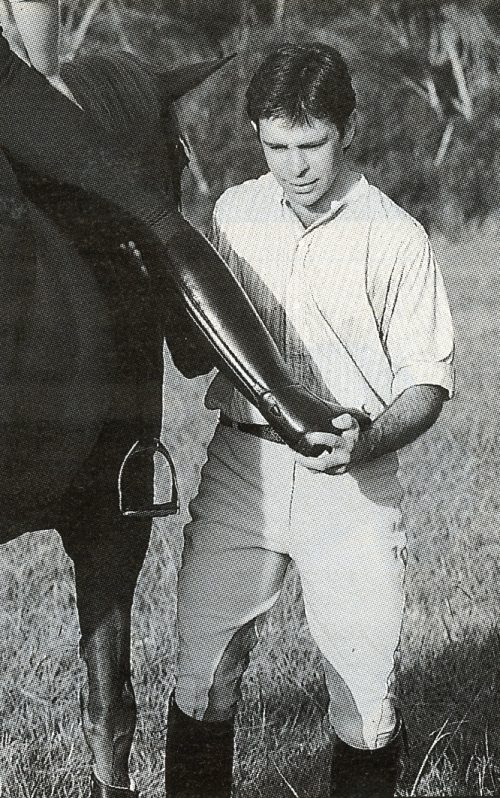
“I think the most important thing any of us can learn on a horse is to stay out of the way of the horse’s natural movement. We are all such doers, we all think we know better than the horse knows what his body needs to do. Didn’t Franz Mairinger spend a lifetime trying to convince us that ‘Horses are made to be horses’? Really the horse has all the knowledge, all we need to do is stay out of his way and encourage the horse to give.”
“Round about this stage I normally ask the pupil to start to include an awareness of hearing and the awareness of smell. Then the student opens his eyes, and as they become adjusted to the light I encourage them to experience the whole spectrum of their vision – the sky, the floor, everything to either side. All this information is coming in because by this time the rider is uncluttered by tensions, physical or mental. I then ask them not to process – just to be aware, an impartial observer of the world that is happening to them.”
“About this time they are generally well into their right brain, becoming more aware of the horse’s needs, and developing their own natural balance. Their riding is improved through this very small exercise, which might take half an hour. And the improvement is enormous, far more than I could achieve if I told them to ‘sit up straight’ or ‘shoulders back, heels down, hands still’ – all those linear demands we so often give ourselves. Demands which isolate specific parts of the body and ignore the effect on the dynamics of the whole rider.”
“Once the rider has this increased sensitivity, and the awareness of the right brain function, I can then say ‘I want you to remember that feeling, remember the state you are in, and I want you to be able to re-create it at any time’. The same with the feeling of the movement in the horse – I want you to be able to re-create that feeling in your body. So that when you want to create a nice walk in your horse, all you have to do is show him This is what it felt like when you were walking nicely. Can I have it again?”‘
“Because you have fitted in so beautifully to the functioning of the horse’s back, he becomes addicted to that feeling, he looks for it because it feels so comfortable and so good. If you slightly change the way you are moving – have an attitude of inviting a slightly lengthened stride, or an attitude of inviting a slower pace – the horse will normally fit in very happily. So you start to control your horse, just by creating the feeling in your body of what you want. ”
”I’ll then let the rider experience this feeling through all the movements of the horse, and keep working on a feeling sense of all those movements. I’ll be helping them to arrange their bodies, mainly through the use of imagery and concentrating on particular sensations.”
It is the extraordinary use of imagery that has struck many of the readers of Sally Swift’s Centred Riding – Richard moves in a slightly different direction: “Personally I’m more inclined to working with feelings. Both of us feed in suggestions to help the rider become more aware of the moving environment. The internal environment of the body and the external environment of the horse and landscape. Sally loves imagery. She is highly visionary.”
“Wheras she responds so strongly to the visual, perhaps I am more influenced by feelings, and that is reflected in my style of teaching.”
“As riding teachers we are fairly limited in terms of language. Language is a left brain activity, so if language becomes a discussion between student and teacher, even if it is a silent discussion with the student thinking – ‘What’s he getting at now, how am I supposed to do that’ – that sort of chattering of the brain, then they miss the feeling of being completely there. Instead of feeding in verbal commands, instructions to do certain things, we tend to feed in information about feelings and images that may help the pupil to open up and that allows them to stay in the right brain feeling state.”
“Every now and then I have to stop people, and we have a good old pow wow, and we chat and discuss, but once they are back riding I like them to be quiet and get involved in the feeling of the movements.”
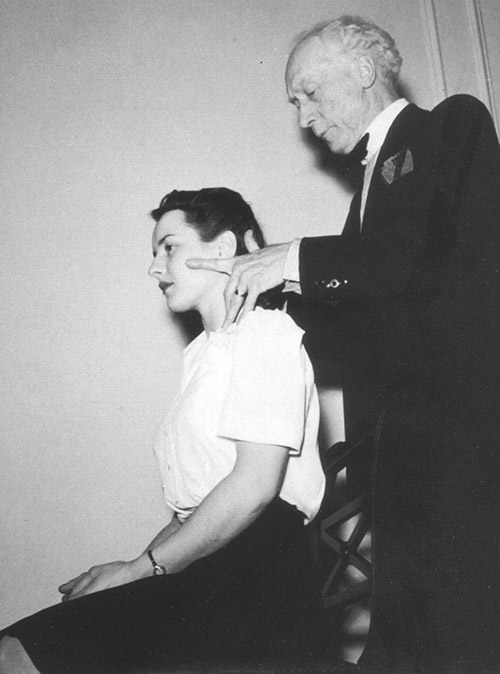
F. M. Alexander teaching…
Readers may perhaps be intrigued with the references to the Alexander Technique, but really we shouldn’t, since F. Mathias Alexander was born in Tasmania in 1869, and died in England in 1955. Alexander developed his technique as a way of becoming more aware of balance, posture and movement, and left Australia in 1904 spreading the system in England and the United States. It was not until the early ’50’s that the first qualified Alexander technique teacher returned to Australia, and this year has seen the establishment of the Melbourne Alexander Teaching Centre. Not surprisingly given the interest of riders in balance (and indeed the high proportion of sore backs in the riding fraternity) the Alexander Technique has been used by many horsemen and women throughout the world. Once again for Richard it was an extension of his interest in mind/body disciplines:
“Marjorie Barstow, the eighty-seven-year old Alexander teacher that I went to in the United States, describes the Technique as ‘an approach to human movement for the conservation of energy’. It is a way of organizing your body so that it is extremely efficient, extremely loose, and extremely free. As opposed to ‘posture’ which is something that you do and hold, it is an approach to movement.”
“We in the riding fraternity automatically apply Alexander’s principles when we consider a horse’s quality of movement yet, we neglect to do this for ourselves. Everybody knows that a horse whose head is set on nicely, and who is poised and balanced with a relaxed jaw, and who is lengthening through his spine, is capable of beautiful balance. If you look at any superbly trained dressage horse, he is very soft, he is very long in the back and very loose in the jaw. That is what gives him the ability to perform beautiful movements.”
“The horse is said to be engaged when he is purposefully lengthening through his poll with every stride in the direction of his forward movement. This purposeful lengthening is a measure of impulsion, it creates an internal dynamic in the body, distributing appropriate tension to all parts. Light, fluid springy movement results. You do not notice the effect of gravity on the movement, unlike when the horse looks heavy and is said to be ‘on the forehand’. We have certain similarities.”
“The human being evolved a very sophisticated ‘anti gravity mechanism’ as an adaption to vertical posture. This mechanisim had to cope with the constant pull of gravity on the head which was now bearing directly down on the spine. It is not surprising that in order to create a similar internal dynamic for the rider, the head needs to move in an upward and forward direction to give freedom of the limbs for movement.”
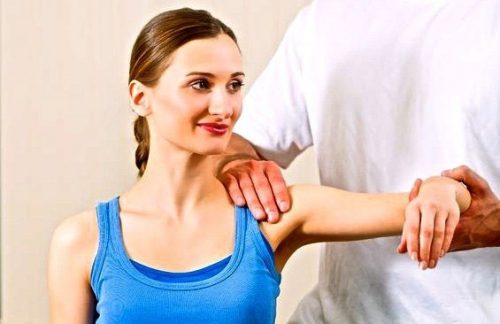
“Many of us hold excess tension in our necks and shoulders. We tend to be ‘on the forehand’. We have forgotten how to distribute our work load through our backs and legs. The excess tensions interfere with the anti gravity mechanism, so the wrong muscles are working to hold us up. Unlike the ‘anti gravity mechanism’ these other muscles tire. This leads us to slumping… and the Alexander Technique.”
“The teacher who started me off in this method said ‘It’s a life sentence’. I like that. It’s something you take with you wherever you go. The time you take to learn it depends on how stuck your body is and how willing you are to change. Once you change the form of your body, it’s very primary to lots of other parts of you – you carry yourself in a certain way because you feel a certain way, you have a certain personality and you relate to the world in a certain way. When you change that it can be something that really makes you think.”
But Richard has no doubt that the Technique is of value to riders: “It is the best thing that I have ever come across for riders. The way the Alexander people approach human movement, fits over a horse just so beautifully, it’s perfect.”
“The proportion of riders who have back problems is horrendous. You find riders everywhere who will tell you their backs are killing them, it’s a huge problem. Maybe it’s not entirely avoidable in that we fall off and get jars and bumps, but if you are riding quiet horses in a sensible manner, I believe that the energy of the horse’s upthrust can help you develop a more open and free body. Horse riding is a sport that uses both sides of the body equally so it tends to balance any imbalances that you may have developed because you are right or left handed. Riding can be wonderful for the body, but the way we ride so often can be very damaging.”
more follows
For Richard, the time spent with Sally Swift opened all sorts of new horizons: “She invited me to go back and work with her in the States, and take over some of her clinics. Sally is now 74 so she is starting to want to slow down. I was very attracted by the idea, but the American Immigration wasn’t so enthusiastic, neither were my family. I have a wife and two children and they weren’t keen on going there at this stage.”
“However I was very lucky that a brand new Alexander teacher’s training course was opening up in Melbourne and they offered me a position in that course, which I accepted. It’s a three year full-time course.”
“At the end of the course, I want to apply the Technique further to riding. I’m not going to stop teaching riding and trying to work out better techniques. The Centred Riding approach is not limited to dressage riders, in fact it is not limited to anything. If you are centred, and you are balanced, if you are able to draw on your natural coordination, then you can ride a racehorse, or play a game of polocrosse, or cut a beast or whatever. I would like to be able to help any horse people in any field. My own interest is dressage. I get more joy from watching and riding in that style, but I also get a lot of joy out of watching a really well trained Quarter horse cut a beast.”
Paradoxically Richard identifies the problem that many of us face in the fact that we try so hard. We are drawn to riding because it makes us ‘feel good’ – then we get caught up. We concentrate in the wrong way:
“When we are riding a horse we need to have all our faculties engaged so that we get enough information. What we like to do is concentrate, and in school we have learnt that we have to try real hard to concentrate. And the harder we try the more we are going to get. So we try a little harder and a sneaking little feeling starts to come into our mind – ‘Maybe I won’t be able to grasp this, so I’ve got to work harder’. Then that sneaking feeling grows – ‘Is everybody else going to get it, and I’ll miss out?”‘
“But by trying so hard we are preventing the attitude of concentration coming over us. Concentration is not something that you can force. Itis something that happens to you out of your fascination for a certain field. Instead of making people work in this linear left brain fashion, if you let them become aware of the right brain, then concentration becomes something that is no longer threatening, it is something that just overtakes them.”
“The fear component in riding is something that is very important and anything that can take away that fear is a bonus. An Alexander teacher has said one of the major reasons that we don’t maintain good posture after childhood is that we never really abandon the fight and flight reaction. That response pulls us into a knot, it pulls our feet up and our head down, and we never learn to let go of that reaction, so our bodies can never completely open up. The harder we try to concentrate, the more we squash our body and cramp its natural functioning. It’s like driving ourselves with the handbrake on.”
“Once we approach concentration from a different point of view, then the rider can become confident and allow the body to grow… ”
“I am very excited about recent developments in riding instruction. But there is always room for change. At the end of last century, when James Fillis was writing his book, he was telling his female readers that they were not capable of riding astride a horse. He warned: ‘Discussion of this subject is therefore useless. Ladies who ride astride get such bad falls that they soon give up this practice’. Most ladies I know have ignored this warning.”
“Fillis was considered to be the greatest rider of his time. Interestingly enough, he died around the time Sally Swift was born.”
“We are still learning. Finding new harmonies, new ways of reaching age old goals. Riding poses challenges but it does not need to be complicated. For those who seek the simple answers within themselves, riding becomes a fascinating journey of self discovery.”


